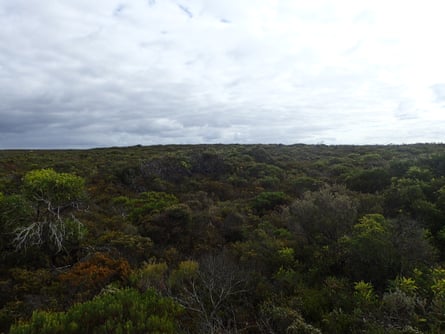PROTECT YOUR DNA WITH QUANTUM TECHNOLOGY
Orgo-Life the new way to the future Advertising by AdpathwayThe southern emu-wren, one of Australia’s smallest birds, weighs just seven grams, about as much as two teaspoons of water.
More tail than bird, its six upright tail feathers make up more than half its length and the males have a distinctive sky-blue patch of feathers on their upper chest and throat.
But conservationists say a planned rocket launcher in its habitat could lead to its demise.
“They’re about the size of a matchbox with a tail about the size of a pencil,” says Therese Pedler, chairperson of the Eyre Peninsula Environmental Protection Alliance in South Australia.
“They’re the most striking, gorgeous little bird.”
Pedler and other community conservation advocates are trying to raise the profile of the little wren, which they say is facing an unprecedented threat from a planned rocket launch facility at Whalers Way, a conservation sanctuary about 32km from Port Lincoln in South Australia.
Sign up: AU Breaking News email
“These little birds are so tiny and so vulnerable – they’ve got no chance against a rocket. It’s just ludicrous,” she said.
Southern emu-wrens are widely distributed along the Australian coastline but three sub-species in South Australia – the Eyre Peninsula, Mount Lofty Ranges and Kangaroo Island populations – have declined to a point that they are listed as endangered under Australia’s environment laws.

The Kangaroo Island subspecies was listed after the summer of 2019-20 when fire – one of the greatest threats to the species – tore through the western end of Kangaroo Island, devastating the southern emu-wren’s habitat. Experts estimate more than half of the local southern emu-wren population perished in the catastrophe.
Past habitat clearing has reduced the Mount Lofty Ranges population to about 300 birds in wet heaths and swamps south of Adelaide.
On the tip of the Eyre Peninsula, fewer than 1,000 birds remain. The federal government gave this subspecies its endangered listing in 2023. The government’s conservation advice states that every known site where the Eyre Peninsula subspecies occurred was habitat critical to its survival.
Last year, the federal government gave the green light to Adelaide-based start-up Southern Launch to construct permanent rocket launch facilities at Whalers Way, a conservation sanctuary that has been protected under a South Australian heritage agreement since the 1990s.
The site is home to one of the largest and most important populations of the Eyre Peninsula southern emu-wren, along with other endangered species.
“When it was approved, I was astounded,” says Prof Hugh Possingham, the vice-president of BirdLife Australia.
Southern emu-wrens rely on heathlands and have a superior ability to move through the dense, low scrub.
“Their super power is to be able to feed and live in this impenetrable vegetation which protects them a lot from predators,” says Possingham.
But the birds are poor flyers. They move slowly, cover small distances and hop along from one bush to the next. For every breeding pair, about a hectare of good quality habitat is required. Fragmentation of their habitat is a serious concern because the birds rely on the connected heaths for their safety.
“The thing that puts them most at risk is habitat fragmentation,” Pedler says.
“They can’t hop from a bush here to one 100 metres away. Because they don’t really fly, they need to be able to hop from bush to bush to bush.
“When you have cars driving through or bulldozers driving through clearing vegetation, these little things can’t just jump across a road or a rocket launching pad.”
Southern Launch has approval to clear up to 24ha of southern emu-wren habitat at Whalers Way. The development would also introduce other threats including noise and light pollution, roads and increased fire risk.
Possingham, Pedler and other conservationists argue a suitable alternative site should be found for the development on land that has already been cleared.
“There’s many equally good locations that don’t involve destruction of nature and affecting an endangered species,” Possingham says.
The South Australian heritage agreement that covers the Whalers Way site would also need to be varied before the development can proceed.
Southern Launch’s chief executive, Lloyd Damp, says orbital launch complexes have to be located on the coast to ensure rocket stages land in the ocean, away from homes and critical infrastructure.
He says the location of Whalers Way within 50km of a major population centre – Port Lincoln – that has amenities and services was also a “key determining factor” in the site selection.
“The lower Eyre Peninsula has over 140,000 hectares of native vegetation and 41,000 hectares has been identified as southern Emu-wren habitat,” he says.
Damp says Southern Launch was committed to delivering a “net environmental benefit” at Whalers Way, including a biodiversity strategy, to ensure native species in the area were protected and to manage the environment through measures such as eradication of feral animals.
Pedler says the existing heritage agreement means that for close to 40 years the Whalers Way site had been an undisturbed area of magnificent coastline, wild ocean for species such as the southern right whale, and nature.
“The southern emu-wren, the Eyre Peninsula variety, it’s numbers are so reduced it’s under threat of extinction,” she says.
“Once the last breeding pair goes you can’t bring them back from extinction.
“This is their habitat and they must be protected at all costs.”


 2 days ago
19
2 days ago
19





















 English (US) ·
English (US) ·  French (CA) ·
French (CA) ·